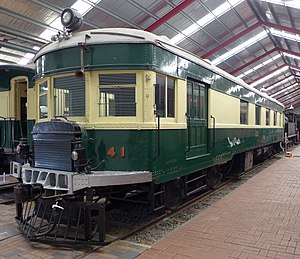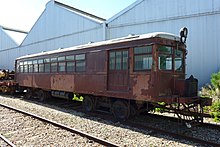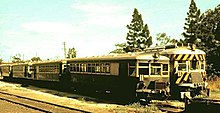
Pichi Richi Railway is a 39 kilometres narrow-gauge heritage railway in the southern Flinders Ranges of South Australia between Quorn and Port Augusta. For much of its length the line lies in the picturesque Pichi Richi Pass, where the line was completed in 1879 as work proceeded north to build a railway to the "Red Centre" of Australia – the Central Australia Railway.
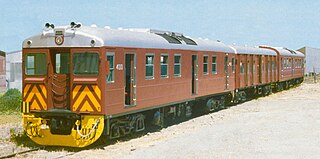
The Redhen railcars was the nickname given to the 300 and 400 classes of diesel-hydraulic railcars designed by the South Australian Railways and built at its Islington Railway Workshops between 1955 and 1971. The railcars, which operated in Adelaide suburban service until 1996, remain a nostalgic part of South Australian memory. Some continue to be operated by the SteamRanger Heritage Railway, the National Railway Museum, Port Adelaide and other railway preservation entities.

The 2000 class and 2100 class were diesel multiple units that operated on the Adelaide rail network between 1980 and 2015. They were built by Comeng in Granville, New South Wales in 1979–1980.
Railmotor is a term used in the United Kingdom and elsewhere for a railway lightweight railcar, usually consisting of a railway carriage with a steam traction unit, or a diesel or petrol engine, integrated into it.

The National Railway Museum, Port Adelaide, South Australia is the largest railway museum in Australia. More than 100 major exhibits, mainly from the South Australian Railways (SAR) and Commonwealth Railways and their successor, Australian National, are displayed at its 3.5 hectares site. A very large archival collection of photographs of those railways and records created by them is also managed by the museum. The museum is operated with a large number of volunteers.

The Diesel Electric Rail Motor (DERM) was a type of railmotor operated by the Victorian Railways in Australia.

The DRC was a class of railmotor operated by the Victorian Railways on its country rail network in Victoria, Australia. The cars were built by Tulloch Limited in New South Wales, and featured aluminium and steel construction, air-conditioning, and twin diesel engines with hydraulic transmissions.

The family of Walker railmotors were a type of diesel railcar operated by the Victorian Railways in Australia.
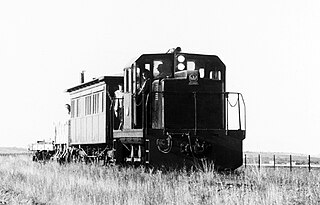
The Commonwealth Railways NC class consisted of two diesel-hydraulic locomotives built by Clyde Engineering, Granville, New South Wales in 1956. The Lakewood Firewood Company, Kalgoorlie was the first owner; the Commonwealth Railways purchased them in 1965. They ceased revenue service in the early 1980s.

The Commonwealth Railways NSU class was a class of diesel-electric locomotives built in 1954 and 1955 by the Birmingham Railway Carriage and Wagon Company, England, for the Commonwealth Railways to be deployed on the narrow-gauge Central Australia Railway and North Australia Railway.
This article lists some of the terminology used at present and in the past by railway employees, railway enthusiasts and railway historians in Australia. Many appear from time to time in specialist, rail-related publications. Significant regional variations exist, indicated by abbreviations of the state or railway.

The 900/800 class railcars were diesel multiple units built by the New South Wales Government Railways between November 1951 and November 1960.

The Commonwealth Railways NB class originated in a shipment of four 0-6-0, 1067 millimetres gauge, saddle tank steam locomotives built by the Vulcan Iron Works of Wilkes-Barre, Pennsylvania. They were imported to Australia in 1916 for construction work at the naval base at Henderson, Western Australia. Their tractive effort was 9500 pounds.
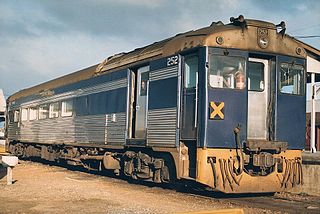
The Bluebird railcars were a class of self-propelled diesel-hydraulic railcar built by the South Australian Railways' Islington Railway Workshops between 1954 and 1959.

The South Australian Railways T class was a class of 4-8-0 steam locomotives operated by the South Australian Railways. Several were sold to the Tasmanian Government Railways; some others operated on the Commonwealth Railways.

A steam railcar is a rail vehicle that does not require a locomotive as it contains its own steam engine. The first steam railcar was an experimental unit designed and built in 1847 by James Samuel and William Bridges Adams. In 1848, they made the Fairfield steam carriage that they sold to the Bristol and Exeter Railway, who used it for two years on a branch line.
The 1100 class railcar or Budd railcar were a type of diesel railcar built by Commonwealth Engineering for the Department of Railways New South Wales in 1961. They primarily operated on the South Coast Daylight Express until withdrawn in 1993.

The South Australian Railways F class is a class of 4-6-2T steam locomotives operated by the South Australian Railways.

The NDH class railcars are a class of self propelled diesel-hydraulic railcars designed by Commonwealth Engineering and built by the Gloucester Railway Carriage & Wagon Company in England for the Commonwealth Railways, Australia in 1954. They were known as Gloucester railcars.

The CB class railcar were a type of Budd Rail Diesel Cars operated by the Commonwealth Railways and Australian National in Australia from 1951 until 1990.
